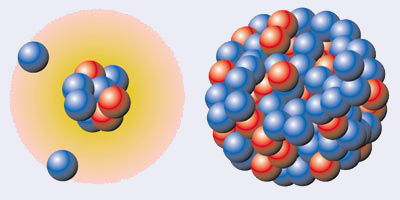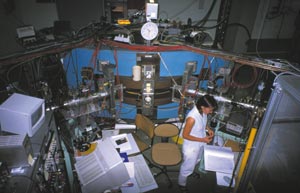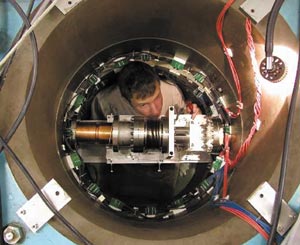The superlarge nuclei studied at CERN’s ISOLDE facility can now vie for attention with the superdeformed and the superheavy, as David Lunney explains.

Foremost among the many open questions in nuclear physics is the determination of the limits of the basic properties of the nucleus. For example, just what is the heaviest nuclear system possible and into what forms does it distort itself? When it comes to nuclear size, measurements have led to the astonishing discovery that the lightest nuclei have a curious tendency to puff themselves up in importance, imitating their bigger (and heavier) relatives. The most famous example is the nuclide 11Li, which has a radius almost equal to that of 208Pb and yet is 20 times lighter. 11Li has such a surplus of neutrons – eight, for only three protons – that the last two are pushed far from the core, forming a so-called halo. This nuclide, which still defies theoretical description, even by the most advanced nuclear models, has recently come under intense scrutiny at the ISOLDE facility at CERN.
The heaviest elements of the periodic table, now reaching at least to Z = 115, have been discovered recently at JINR in Dubna and at GSI in Darmstadt. They are located well beyond the heaviest known stable elements of lead (Pb, Z = 82) and bismuth (Bi, Z = 83), across the gulf of spontaneously fissioning actinides, which is dotted by a small archipelago consisting of stable thorium (Th, Z = 90) and uranium (U, Z = 92). The new region being explored in Darmstadt and Dubna is known, naturally, as the “island” of superheavy elements. [The naming of these elements is an issue in itself, which is subject to stringent verification by the International Union of Physics and Applied Chemistry (IUPAC). At a recent ceremony the discoverers of Z = 110 were granted their wish to name their foundling darmstadtium (Ds) after the city of their institute, GSI.
Shape shifters
Another example of nuclear extremes concerns shape and is a consequence of nuclear deformation – the departure from a normal, spherical shape. Some nuclides, particularly those with unbalanced proton-to-neutron ratios, are more comfortable assuming some type of contortion, typically a cigar shape (prolate) or a disc shape (oblate). A recent trend in experiments in nuclear physics was to create nuclei with the highest possible angular momentum. The consequence of so much spin was a nucleus that was so distorted it was classed as superdeformed. Such nuclei were studied by a very special type of spectroscopic footprint: a comb-like energy spectrum produced by a series of cascading gamma-ray decays as the whirling nucleus shed its enormous excess of rotational energy (Walker and Dracoulis 1999).
CERN’s online isotope mass-separator facility, ISOLDE, does not have the beam energy necessary to produce either superdeformed or superheavy nuclides. However, ISOLDE does have the capacity to produce nuclides of another superlative character – the superlarge. To do this ISOLDE must be pushed to its limit: the neutron drip line (see figure 1). Imagine producing heavier isotopes of an element by adding neutrons to a given number of protons to the point where the neutron-saturated nucleus cannot hold any more. Like a water-soaked sponge, the nucleus drips neutrons.
Nuclides at the drip line exhibit behaviour that is unlike that of stable or even mildly radioactive species, and as such warrant special study. One interesting example is when loosely bound neutrons stray from a more equilibrated cohesive core to form what are called halo nuclei. These wayward neutrons considerably extend the nuclear radius, making it much larger than a nucleus in which the neutrons do not so greatly outnumber the protons – hence the term “superlarge”.

Superlarge nuclides are a conundrum to theorists as the halo radii are in fact larger than the range of the strong interaction that binds the protons and neutrons within the nucleus. The case of 11Li, where the halo is formed from two neutrons, is particularly curious (see figure 2). Not only is the two-neutron subsystem unbound, but so is the 10Li subsystem, which consists of a 9Li core plus a neutron – an example of a nucleus that drips one neutron. So if one of the halo neutrons is removed from 11Li then the other comes away too. These systems have been dubbed Borromean (of Italian nobility) after the heraldic symbol of three rings which are connected in such a way that the removal of any one ring frees the other two (see figure 3).
In 2003 two experiments at ISOLDE were devoted to the most important fundamental properties of 11Li – its size and its weight. In fact these two quantities are related, as the binding energy (from the mass) determines the radial extent of the system. But given the particular behaviour of the outer, valence neutrons, the recipe is not so straightforward.
Mass measurements and laser spectroscopy
The MISTRAL experiment recently measured the mass of 11Li. MISTRAL is a precision mass spectrometer that is particularly adapted to measurements of very-short-lived nuclei, and with a half-life of only 8.6 ms 11Li was extremely well suited to MISTRAL’s rapid measurement technique. Though previously known, the mass value was considerably improved and in fact slightly modified by about 70 keV. While this is small compared with the total mass of the system of around 11 GeV, it is significant with respect to the two-neutron binding energy of only 300 keV (Bachelet 2004).

The radial extent – and shape – of superlarge nuclei can also be determined by laser spectroscopy. This is an elegant marriage of atomic and nuclear physics techniques that probes the subtle effect of the small but finite nuclear volume on the distant electron orbitals. The measured quantity in this case is the nuclear quadrupole moment which, like the mass, was previously known but with insufficient precision to constrain the ever-increasing sophistication of theoretical models (Borremans 2004).
In the past, the two neutrons forming the 11Li halo were considered with respect to a 9Li core, which was regarded as inert. The results of these new measurements, especially that of the quadrupole moment, will have an important bearing on the polarization of the core by the halo neutrons – an effect that is only now starting to be treated by theory (Jensen et al. 2004).

Given the importance of superlarge nuclides, ISOLDE, in collaboration with the Rutherford Appleton Laboratory in the UK, has invested considerable effort in the development of specialized targets for the production of such nuclei. A prime example is the target constructed by pressing together more than 100 tantalum foils only 2 µm thick. 11Li is produced in the target by fragmentation of the tantalum nuclei by the proton beam from the PS Booster at CERN. The thinner the foils constituting the target matrix, the faster the short-lived drip-line nuclides can diffuse out to be ionized and transported to the experiment (Bennett et al. 2002).

11Li is not the only superlarge nuclide that is produced at ISOLDE. Others include, for example, 14Be, which has a two-neutron halo, and 19C, which has a one-neutron halo. 17Ne has also been the subject of study by laser spectroscopy due to its interest as a nuclide with a one-proton halo, and it will come under scrutiny again in 2004 when its mass is measured by MISTRAL’s sister experiment ISOLTRAP.
The superlarge 11Li has, meanwhile, been the subject of a myriad of experimental and theoretical studies, with two recent reviews (Jonson and Jensen et al. 2004) chronicling the superlarge saga. It will fall to nuclear theory to fit all the pieces into place, hopefully reconciling all the superlative behaviour of the nuclear system after the fashion of supersymmetry, supergravity and superstrings: a veritable supermodel.
Further reading
C Bachelet 2004 PhD Thesis, Université de Paris Sud.
J R J Bennett et al. 2002 Nucl. Phys. A 701 327.
D Borremans 2004 PhD Thesis, University of Leuven.
X Jensen et al. 2004 Rev. Mod. Phys. 76 215.
B Jonson 2004 Physics Reports 389 1.
P Walker and G Dracoulis 1999 Nature 399 35.





